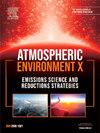Influence factors on airborne pollen dispersal in a tropical island over China: morphology and meteorology
IF 3.4
Q2 ENVIRONMENTAL SCIENCES
引用次数: 0
Abstract
Airborne pollen is an important primary biological aerosol particle in tropical regions, greatly impacting climate and human health. However, the pollen morphology in tropical areas, particularly their impact on pollen dispersal, remains unknown. To determine the relationship between the dispersal and morphology of airborne pollens, we collected the airborne pollen by Durham samplers at three vertical heights, including 1.5 m, ∼18.5 m, and ∼55 m in Haikou City, China. Pollen particles showed higher concentrations at higher heights above ground level. The quantitative analysis of single pollen particles based on the size index showed that the airborne pollen sizes in the tropics were mainly small (10–25 μm) (45.9%) and medium (25–50 μm) (32.2%). That's consistent with the pollen morphology of spring and summer flowering plants in the surrounding areas. The proportions of very small (<10 μm) and small (10–25 μm) pollen particles increased significantly with the vertical height. The shape index showed the prominent shape of airborne pollen was subspheroidal/spheroidal (∼80%). The pollen concentration of other shapes, like prolate or oblate, slightly increased with height. The Pearson correlation analysis showed that local meteorological conditions had an important role in influencing pollen amounts, with some associations found to be statistically significant. Temperature variables had significant positive correlation with pollen amounts, especially the maximum temperature (r = 0.71, P < 0.01). The rainfall and relative humidity exhibited a negative correlation with pollen concentration. Notably, pollen release was influenced by meteorological factors with a 1–7 day lagged effect. This study provided a near-ground vertical profile of tropical pollen concentration and morphology. These findings also offer a comprehensive understanding of how airborne pollen morphology and meteorological factors influence their transport and deposition characteristics on a tropical island.

中国热带岛屿空气传播花粉的影响因素:形态学和气象学
空气中花粉是热带地区重要的初级生物气溶胶颗粒,对气候和人类健康有重要影响。然而,热带地区的花粉形态,特别是它们对花粉传播的影响,仍然是未知的。为了确定空气中花粉的传播与形态之间的关系,我们在中国海口市的三个垂直高度(1.5 m、~ 18.5 m和~ 55 m)用达勒姆采样器采集了空气中花粉。花粉浓度在地面以上越高越高。基于粒径指数的单粒花粉定量分析表明,热带地区空气中花粉粒径主要为小(10 ~ 25 μm)(45.9%)和中(25 ~ 50 μm)(32.2%)。这与周边地区春夏开花植物的花粉形态一致。随着垂直高度的增加,极小(10 μm)和极小(10 ~ 25 μm)花粉所占比例显著增加。形状指数显示空气中花粉的突出形状为近球形/球形(约80%)。其他形状的花粉浓度,如长形或扁形,随着高度的增加而略有增加。Pearson相关分析表明,当地气象条件对花粉量有重要影响,部分相关性具有统计学意义。温度变量与花粉量呈显著正相关,尤其是最高温度(r = 0.71, P <;0.01)。降雨量和相对湿度与花粉浓度呈负相关。值得注意的是,花粉释放受气象因子的影响,存在1 ~ 7 d的滞后效应。本研究提供了热带花粉浓度和形态的近地垂直剖面。这些发现还有助于全面了解空气中花粉形态和气象因素如何影响其在热带岛屿上的运输和沉积特征。
本文章由计算机程序翻译,如有差异,请以英文原文为准。
求助全文
约1分钟内获得全文
求助全文
来源期刊

Atmospheric Environment: X
Environmental Science-Environmental Science (all)
CiteScore
8.00
自引率
0.00%
发文量
47
审稿时长
12 weeks
 求助内容:
求助内容: 应助结果提醒方式:
应助结果提醒方式:


